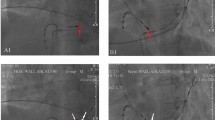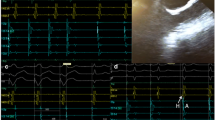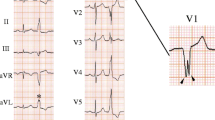Abstract
Background
Permanent junctional reciprocating tachycardia (PJRT) is an infrequent form of atrioventricular re-entrant tachycardia. We report the clinical and electrophysiological properties of PJRT and outcomes of radiofrequency catheter ablation (RCA) in a large group of patients.
Methods
We included 62 patients with the diagnosis of PJRT. Radiofrequency catheter ablation was performed in all.
Results
Location of accessory pathway was right posteroseptal in 37 (59,7%) cases, right midseptal in 3 (4,8%), left posterior in 7 (11,3%), left lateral in 5 (8,1%), left posterolateral in 3 (4,8%), left anterolateral in 2 (3,2%), left posteroseptal in 2 (3,2%), middle cardiac vein in 2 (3,2%), and left coronary cusp in 1 (1,6%). Single procedure success rate was 90.3%. None of patients had recurrence during follow-up after repeat ablations. Overall long-term success rate was 98.4%. Left ventricular systolic function recovered in all patients with tachycardia-induced cardiomyopathy (TIC).
Conclusion
Retrograde decremental accessory pathways are mainly located in posteroseptal region. Radiofrequency catheter ablation is a safe and effective approach in patients with PJRT.




Similar content being viewed by others
References
Coumel P. Junctional reciprocating tachycardias. The permanent and paroxysmal forms of A-V nodal reciprocating tachycardias. J Electrocardiol. 1975;8(1):79–90. https://doi.org/10.1016/s0022-0736(75)80043-4.
Gallagher JJ, Sealy WC. The permanent form of junctional reciprocating tachycardia: further elucidation of the underlying mechanism. Eur J Cardiol. 1978;8(4–5):413–30.
Critelli G, Gallagher JJ, Monda V, et al. Anatomic and electrophysiologic substrate of the permanent form of junctional reciprocating tachycardia. J Am Coll Cardiol. 1984;4(3):601–10. https://doi.org/10.1016/s0735-1097(84)80108-4.
Coumel P, Cabrol C, Fabiato A, et al. Tachycardie permanente par rythme re’ciproque Preuves du diagnostic par stimulation auriculaire et ventriculaire. Arch Mal Coeur. 1967;60:1830–64.
Ticho BS, Saul JP, Hulse JE, et al. Variable location of accessory pathways associated with the permanent form of junctional reciprocating tachycardia and confirmation with radiofrequency ablation. Am J Cardiol. 1992;70(20):1559–64. https://doi.org/10.1016/0002-9149(92)90457-a.
Shih HT, Miles WM, Klein LS, et al. Multiple accessory pathways in the permanent form of junctional reciprocating tachycardia. Am J Cardiol. 1994;73:361–7.
Kose S, Iyisoy A, Barcin C. A permanent junctional reciprocating tachycardia with atypical location, treated with radiofrequency catheter ablation. Acta Cardiol. 2002;57:371–5. https://doi.org/10.2143/AC.57.5.2005456.
Amasyali B, Kose S, Aytemir K, et al. A permanent junctional reciprocating tachycardia with an atypically located accessory pathway successfully ablated from within the middle cardiac vein. Heart Vessels. 2006;21(3):188–91. https://doi.org/10.1007/s00380-005-0848-2.
Kalbfleisch SJ, Rhodes TE. A rare case of permanent junctional reciprocating tachycardia ablated on the roof of the left atrium. J Cardiovasc Electrophysiol. 2013;24(4):464–7. https://doi.org/10.1111/j.1540-8167.2012.02440.x.
Rodríguez-Mañero M, Fernández-López XA, González-Melchor L, García-Seara J, et al. Permanent junctional reciprocating tachycardia in a patient with an atypically located accessory pathway in the left lateral mitral annulus. Rev Port Cardiol. 2016;35(1):59.e1-59.e595. https://doi.org/10.1016/j.repc.2015.07.012.
Lindinger A, Heisel A, von Bernuth G, et al. Permanent junctional re-entry tachycardia. A multicentre long-term follow-up study in infants, children and young adults. Eur Heart J. 1998;19(6):936–42. https://doi.org/10.1053/euhj.1997.0860.
Dorostkar PC, Silka MJ, Morady F, Dick M 2nd, et al. Clinical course of persistent junctional reciprocating tachycardia. J Am Coll Cardiol. 1999;33(2):366–75. https://doi.org/10.1016/s0735-1097(98)00590-7.
Vaksmann G, D’Hoinne C, Lucet V, et al. Permanent junctional reciprocating tachycardia in children: a multicentre study on clinical profile and outcome. Heart. 2006;92(1):101–4. https://doi.org/10.1136/hrt.2004.054163.
Peters S. Tachycardiomyopathy: a case of dilated cardiomyopathy due to permanent junctional reentrant tachycardia. Int J Cardiol. 2016;207:233–4. https://doi.org/10.1016/j.ijcard.2016.01.172.
Haïssaguerre M, Gaïta F, Marcus FI, et al. Radiofrequency catheter ablation of accessory pathways: a contemporary review. J Cardiovasc Electrophysiol. 1994;5(6):532–52. https://doi.org/10.1111/j.1540-8167.1994.tb01293.x.
Gaita F, Haissaguerre M, Giustetto C, et al. Catheter ablation of permanent junctional reciprocating tachycardia with radiofrequency current. J Am Coll Cardiol. 1995;25(3):648–54. https://doi.org/10.1016/0735-1097(94)00455-Y.
Aguinaga L, Brugada J, Anguera I, et al. Seguimiento a largo plazo de pacientes con la forma permanente de taquicardia recíproca de la unión tipo Coumel tratados mediante ablación con radiofrecuencia [Long term follow-up in patients with the permanent form of junctional reciprocating tachycardia treated with radiofrequency ablation]. Rev Esp Cardiol. 1998;51(3):218–23. https://doi.org/10.1016/s0300-8932(98)74736-0.
Hill AC, Silka MJ, Wee CP, et al. Characteristics of decremental accessory pathways in children. Circ Arrhythm Electrophysiol. 2016;9(11):e004190. https://doi.org/10.1161/CIRCEP.116.004190.
Chen SA, Tai CT, Chiang CE, et al. Electrophysiologic characteristics, electropharmacologic responses and radiofrequency ablation in patients with decremental accessory pathway. J Am Coll Cardiol. 1996;28(3):732–7. https://doi.org/10.1016/0735-1097(96)00219-7.
Becker AE, Anderson RH, Durrer D, et al. The anatomical substrates of wolff-parkinson-white syndrome. A clinicopathologic correlation in seven patients. Circulation. 1978;57(5):870–9. https://doi.org/10.1161/01.cir.57.5.870.
Meiltz A, Weber R, Halimi F, et al. Permanent form of junctional reciprocating tachycardia in adults: peculiar features and results of radiofrequency catheter ablation. Europace. 2006;8(1):21–8. https://doi.org/10.1093/europace/euj007.
Kang KT, Potts JE, Radbill AE, et al. Permanent junctional reciprocating tachycardia in children: a multicenter experience. Heart Rhythm. 2014;11(8):1426–32. https://doi.org/10.1016/j.hrthm.2014.04.033.
Author information
Authors and Affiliations
Corresponding author
Ethics declarations
Ethics approval
The study was approved by the Institutional Ethical Committee.
Consent to participate
Written informed consent was obtained from all individual participants included in the study.
Conflict of interest
The authors declare no competing interests.
Additional information
Publisher's note
Springer Nature remains neutral with regard to jurisdictional claims in published maps and institutional affiliations.
Rights and permissions
About this article
Cite this article
Gökoğlan, Y., Vurgun, V.K., Kabul, H.K. et al. Radiofrequency catheter ablation of patients with permanent junctional reciprocating tachycardia and long-term follow-up results. J Interv Card Electrophysiol 63, 461–469 (2022). https://doi.org/10.1007/s10840-021-01057-0
Received:
Accepted:
Published:
Issue Date:
DOI: https://doi.org/10.1007/s10840-021-01057-0




